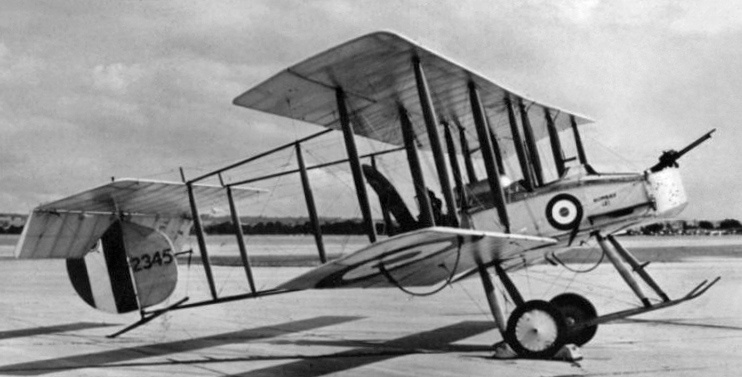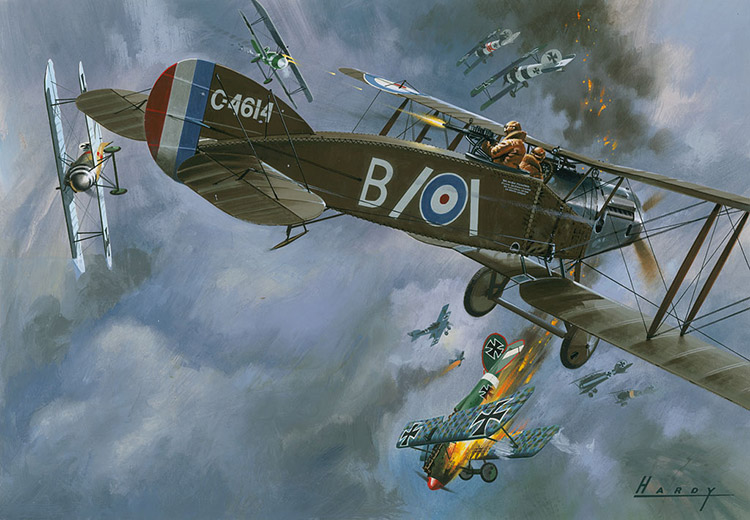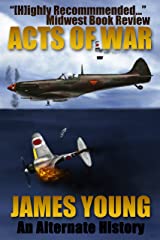“The fighter pilots have to rove in the area alotted to them in any way they like, and when they spot an enemy they attack and shoot him down, anything else is rubbish.”–Manfred von Richthofen, a.k.a. “The Red Baron”
It’s hard to believe that aerial warfare has only been going on for a little over 100 years. That we’ve gone from folks getting around in glorified tractor engines with wings…

to multi-million dollar jet fighters:

To put this in perspective, from say 1715-1815, the basic mechanics of ground warfare did not change all that much. Some battle captain who got a little too frisky with a mage’s second wife and was teleported 100 years into the future from 1715-1815 would still be able to give a decent account of himself. Sure there’d be some moderate nuances about Napoleonic maneuver, but after about 5 days of intense study, he’s not going to make too much an idiot of himself at Waterloo. Put that guy flying the Vickers Gun Bus up top in the cockpit of the SAAB Gripen below at 10,000 feet? Well, you’re gonna get about 30 seconds of video to add to that YouTube of “Greatest Air Crashes.”
So why should people care about fighters? Well, because air superiority sort of makes the military world go round since ~1914. Although bomber combat did technically start a couple years earlier with the Italians chucking some bombs at folks in North Africa, the “big show” of aerial bloodletting got its start with The Great War. Don’t get me wrong–the shenanigans didn’t start off right way. There are myriad accounts of reconnaissance pilots from both sides during the Battle of the Marne waving at each other as they went about their trade. Many pilots likely felt that it was dangerous enough getting from Point A to Point B that it would not be prudent to add the degree of difficulty of, you know, kill each other. I imagine it was like seeing a rival cabbie at the gas station:
*joyful early 20th century chamber music*
“Oh! Guten Tag, Byron!”
“Bloody hell Wilhemn, haven’t seen you in a couple of weeks! How’s trade?”
“Oh you know, the usual—taking pictures so our artillery chaps can blow the living hell out of your infantry again!”
*music screeches to a stop*
That’s right, either someone didn’t have enough coffee some morning, a pilot’s sibling got blown to a bloody mess or, more likely, higher headquarters realized maaaaaaayyyybbbee they should encourage their reconnaissance chaps to go after the other side’s reconnaissance chaps in a most impolite way.
Initial attempts were pretty much improvised, as pilots and observers started shooting pistols, unloading shotguns, and even tossing bricks at one another. It was like a big gang fight in the sky until…well, until someone brought a machine gun to the party. This, in retrospect, likely took a bit longer than it should have, even given how heavy and unwieldy machine guns were at this point. Once that first step was taken, however, the race was on…except pilots quickly realized that propellers and machine guns didn’t mix and observers were unconscionably heavy. This meant most of your early fighters were two seater, open air types in which one bloke flew, and the other blazed.
The problem with the above set up was that two seat aircraft were far less maneuverable than single seat aircraft. Moreover, a well-handled single seater could get someplace far faster than a two seater. However, despite those advantages, there was the one major disadvantage with most single seaters–machine gun fire + own propeller = glider. This simple equation led to smart guys like Roland Garros (Allies) and Anthony Fokker (Central Powers) to apply thought on how to “interrupt” a firing machine gun so it didn’t blow the prop off. Depending on what account you read, the following events occurred between April-July 1915 in this general sequence:
- Garros came up with a semi-reliable system first
- Fokker came up with a less reliable system second
- Garros was uber motivated to get to the German killing, so he simply reinforced his prop blades with steel wedges to deflect the “oopsies”
- German commanders, angry that Garros was conducting a winged spree shooting, told Fokker he better either figure crap out or he was going to get an all expense ticket stamped for someplace muddy, rat-infested, and within British artillery range
- Garros got a little greedy going after kills and ended up shot down behind German lines. Due to wet conditions, Garros could not get his plane to burn before capture.
- Fokker examined Garros’ system and realized that the Frenchman and he had solved different pieces of the puzzle
- Fokker perfected interruptor gear, calling it a synchronization mechanism due to it synchronizing the machine gun’s firing with the propeller’s movement.
Regardless of the exact timing or veracity of the above, the end result is not in dispute. By July 1915 the Germans were able to put interruptor gear and forward mounted machine guns on their fighters. Thus began what was called “The Fokker Scourge,” i.e., the point where Fokker fighters had a marked advantage over their British opponents and started blasting the Royal Flying Corps out of the sky.

“Well this is just going to be an unsightly bad day at the office…”
Now, if you’re imagining a huge cloud of swirling multi-colored biplanes at this point, along with one conspicuous flying doghouse…you’re a bit early. As you can see from the above painting, early pilots hunted prey the same way George Thorogood drank: Alone. As in, “Hey, I’m going to go patrol this sector. If I happen to see something flying, I’m gonna shoot it. So don’t fly your happy behind over this creek here, because I don’t want to turn you into a flaming comet on accident.”
This isn’t as crazy as it seems at first blush. Take a look at early World War I monoplanes, then consider that visibility wasn’t always your friend. Plane comes out of a cloud bank, a pilot didn’t want to spend precious seconds trying to figure out if it’s his good buddy Hans or some guy named Jacques. On top of that, aircraft mass production still had not hit its stride. These were still machines that, by and large, a bunch of folks were putting together with canvas and glue in a glorified garage. That translated to not that many numbers at the front line. Combine this with the large amount of frontage from the North Sea to the Swiss Border, and you start to understand why men could fly for literally hours without seeing anything.
Horrified by the carnage of the trenches, belligerents’ populations began to lionize these winged “knights of the air” for their allegedly more noble existence. The dashing “ace” (designated after five kills) was born, and everyone just ignored the fact that men were puttering around in flying canvas fire sacks. Because, hey, blasting holes in one another until someone hits a powerplant, ignites a fuel tank, or incapacitates the other pilot is way cooler than…
*pause* Okay, fine, it beats life in a trench, but not by much. Lest there be any confusion, parachutes in fighter aircraft were not a thing until 1918, and then only for the Germans. In some ways, catching a volley of .303 to the head was the best outcome, as then at least the lights just went out. All too often, bullets cut a fuel line, petrol caught a hot engine, and the unlucky pilot became the next contestant on Mr. Newton’s Flaming Fireball of Funtime. It was not unheard of for men in this situation to decide they’d rather jump to their doom than sizzle all the way down. Less common, but not at all apocryphal, were reports of men who decided to blow their brains out rather than wait around to see rather kinetic or thermal energy would be their undoing.
Around the winter of 1915-1916, as the Fokker Scourge started to wind down, this solitary or extremely small group method of hunting started to change. There were many reasons for this that I won’t get into. Just know that by the Battle of Verdun, both sides were operating in at least 3-6 ship formations. As the numbers increased on both sides, committing flying manslaughter started to get complicated. The old hands, like Oswald Boelcke and Max Immelmann had previously noted patterns to their engagements. As they began fighting a dual battle between combat fatigue and training new pilots (“Oh my God, you guys are a bunch of newbs!”—translated from the original German), these first generation aces started writing down rules and passing along maneuvers. A similar movement was started on the Allied side, and in this manner the first attempts at professionalization rather than just flying around shooting were begun. This is critical, as this tactical thinking soon led to operational theory.
Complementing these individual attempts and theorizing were decisions made about unit organizations. The German Imperial Air Arm, due to the growing discrepancy in numbers between the Allies and Central Powers, started to organize into squadrons (Jastas). These Jastas, in turn, began being shuffled from one point to another along the line like a traveling carnage troupe, with each unit having distinctive color schemes. It was thus the term “Flying Circus” was born, as if you got a whole bunch of Jastas together it started to look like Ringling Brothers (see here for color schemes—) in the sky. The Allies, in contrast, had sufficient numbers to maintain squadrons in a given sector, dressed their planes in plain drab, and seldom shifted except in preparation for major offensives. In any case, rather than the blundering street fights or serial murders of the earlier phases, by 1917 aerial forces were often being employed to create certain operational effects in support of ground operations. Want your enemy’s observation balloons to get lit up so you could shift a few battalions in relative peace? Send a squadron of Camels to get it done. Royal Flying Corps getting a little uppity in your sector? Jasta 2 will be on the next train. Slowly, principles like concentration of force and air superiority / supremacy began to be born in practice if not formally elucidated (yet).

The Tao Of Dogfighting Part I
Some eternal truths began to emerge as the war wore on. (This is James’s way of saying that Bloody April and Plan 1919 are kinda important, but we’re not touching them here.) I’ll hit the long-term high points here:
1.) The majority of folks who got shot down never knew what hit them. Those who were lucky enough to survive crash landings often said something akin to, “One second I’m flying along, doing my thing, trying not to run into anybody in the formation. Next? I’ve got my bloody observer’s brains all over my neck and the wing’s about to fall off.” Boelcke initially and von Richtofen after him were particularly notorious for passing up kills if the poor bastard they were about to blast showed any signs of seeing them coming. While this extreme was frowned upon in later wars, the fact remained many, many pilots got to see St. Peter before seeing their assailant.
2.) A majority of the killing was done by a minority of the pilots. Michael Spick, a noted aviation author, made lots of money off a book called The Ace Factor in which he tried to explain this phenomenon. Spick tied it to “situational awareness,” which was the buzzword du jour of the time he was writing. Basically SA (as situational awareness is often shortened to) was the ability to keep track of the moving chess pieces of an aerial flight much better than the guy who may be doing well to keep from ramming someone else in his own formation. I’m simplifying a bit, but Mr. Spick is both right and wrong. While SA is always important, what is almost as critical is a proficiency in the weapons of a pilot’s particular era. Or put another way, the reason aces are, well, aces is that they’re able to effectively employ their given weapons system.
Note that I said “employ,” not shoot accurately. As will be discussed later, some of the best aces of World War I and II were terrible shots. As in, Aaron Burr crossed with Elmer Fudd terrible shots. Aiming in three dimensions at speeds the human body was not designed to attain while simultaneously being stalked oneself is not a recipe for accurate shooting. This also contributed to a disturbing tendency for people to open fire well outside of their weapons’ “envelope,” i.e. the parameters were a chance to hit were particularly high.
3.) In aerial combat, it is better to carry through a miscalculated action with great zeal than to have the slightest hesitation under optimal circumstances. Put in modern terms, “go big or go home.” World War I aircraft did not have what modern parlance deems “energy,” i.e. the combination of engine power, aerodynamics, and maneuverability to engage in extended dogfights. With a few exceptions (Richtofen versus Hawker comes to mind), most pilots engaging in a turning battle quickly overstepped their aircraft’s parameters, stalled out, and then became sitting ducks for whomever they were facing. Get in, get blasting, and get out is a mindset that would carry through to the next few European contretemps and beyond.
We’re Over 2,000 Words and Eyes Are Glazing Over
Many important things happened in the last year of the war, but that’s basically what Wikipedia is for. The big takeaway for fighters is that, like all aircraft, by the end of the war they’d gotten bigger, faster, and more lethal. That Fokker Eindecker causing RFC pilots to wet themselves in 1915? It was armed with a single machine gun and had a top speed of 86 mph. By 1918, a German fighter pilot could strap into a Fokker D VIII with two synchronized machine guns and a blazing speed of 127 mph. The Allied fighter pilot having to fight him? Tooling around in a SPAD fighter with a top speed of 135 mph and similar armament. Combat had become massive furballs and often involved bombers running around in large formations. Sometimes the poor bastard at the controls would be expected to do his job at night and versus large airships at altitudes where breathing was difficult. By the last six months of 1918, aerial encounters were occurring in numbers that presaged future events. When the guns finally fell silent in November of that year, all parties involved recognized how far all aircraft had come and how far they could potentially go. Even as the idealistic spoke of “The War to End All Wars,” the cynical began to wonder what would happen the next time young men had to duel for control of the skies.
As I’m doing each of this series, I’ll do a recommended reading list. There will be three books for the casual reader on the topic, followed by one you probably only want to read if this is something you really love.
Three books for the masses:
The Canvas Falcons by Stephen Longstreet
They Fought for the Sky by Quentin Reynolds
Aces Falling by Peter Hart
One book for the monkhood:
No Parachute by Arthur Gould Lee.




EXCELLENT!!!